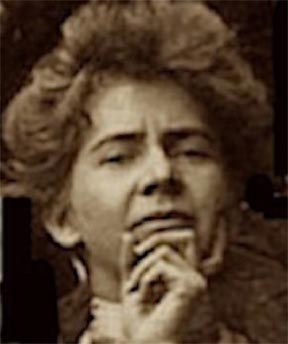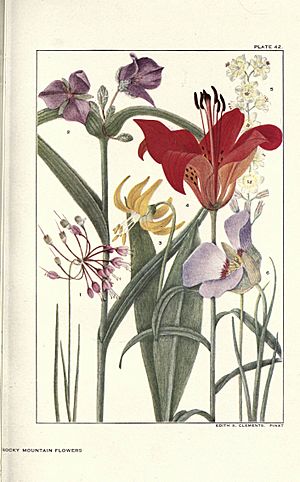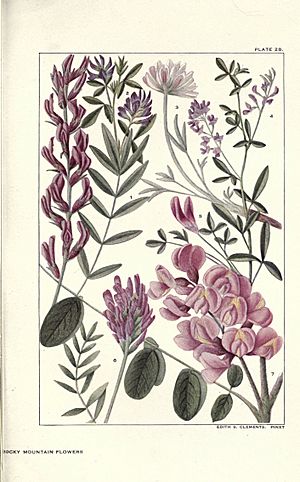Edith Clements facts for kids
Edith Gertrude Clements (1874–1971) was an amazing American botanist and artist. She was one of the first people to study how plants live in their natural environments, a field called botanical ecology. She was also the first woman to earn a Ph.D. (a very high degree) from the University of Nebraska.
Edith worked closely with her husband, Frederic Clements, who was also a botanist. They were like a famous science team, often compared to the Curies! Together, they started a special research place called the Alpine Laboratory in Colorado. Edith was also a talented artist who drew beautiful pictures for her own books and for books she wrote with Frederic. It's hard to tell their work apart because they did so much together.
Early Life and Learning
Edith Gertrude Schwartz was born in 1874 in Albany, New York. Her parents were George and Emma Schwartz. Her father was a pork packer from Omaha, Nebraska.
Edith went to the University of Nebraska (UNL). She was a very good student, joining special honor societies. She earned her first degree in German in 1898. Later, she wrote a big paper about how plant leaves are built and how they relate to their surroundings.
She started her career teaching German at UNL from 1898 to 1900. There, she met Frederic Clements, a botany professor. He helped her decide to study plants. At that time, the Universities of Nebraska and Minnesota were important places for studying phytogeography. This is the study of where different plant species grow around the world. Edith chose this as her main area of study. In 1904, she earned her Ph.D. in botany. This made her the first woman to get a Ph.D. from UNL!
Edith and Frederic got married in 1899.
Adventures in Botany
After getting her Ph.D., Edith worked as a botany assistant at the University of Nevada from 1904 to 1907. Frederic also taught there. To earn money, they spent several summers collecting plants. They put together a valuable collection of about 530 Colorado mountain plants. They added careful notes and 100 photos. These collections were sold to science groups. Later, they made another collection of over 600 non-flowering plants like mosses and ferns.
In 1909, Edith became a botany instructor at the University of Minnesota. Frederic had started leading the botany department there two years earlier. In 1917, Frederic stopped teaching to focus on research. The Carnegie Institution, a science organization, funded their work for many years. Edith was named a field assistant by the Carnegie Institution.
Starting in 1917, the Clementses spent their winters doing research. They worked at Carnegie-funded places in Arizona and later in California. Their summers were spent at their own plant research station. This was the Alpine Laboratory at Pikes Peak, Colorado. Edith taught botany there, and Frederic was the director. They trained many future botanists and ecologists at this lab. It was active for 40 years, closing in 1940. They wrote many books and articles together. Edith also used her language skills to translate some of their work into other languages.
During the Dust Bowl years, when much of the land was dry and dusty, Edith and Frederic traveled around the Great Plains. They helped teach people how to protect their farm and ranch land.
Edith was a skilled botanical artist. She drew pictures for many of their joint books. These included Rocky Mountain Flowers (1914) and Flowers of Coast and Sierra (1928). She also illustrated Frederic's solo books. The famous writer Willa Cather admired their work greatly. Cather once said she would rather have written the Clements' wildflower book than all her own novels!
In 1960, when she was 86, Edith wrote a fun book called Adventures in Ecology. In it, she shared stories of her life with Frederic. She showed how she did many jobs to support their trips. She was a driver, mechanic, cook, and even a photographer and artist. Frederic himself believed Edith would have been one of the world's best ecologists if she hadn't spent so much time helping his career.
Edith's funny writing style is clear in this story about starting one trip:
Friendly neighbors stood around, offering advice, warnings and gloomy prophecies as well as bets on the impossibility of finding space in one car for the appalling number of things that seemed to be absolutely indispensable for the venture. I won the bets for I had a diagram that showed a 'place for everything' and finally I had 'everything in its place.' That is, everything except a pile of sugared and buttered pancakes, left from breakfast. Ginger had planned to have them for lunch, but there was absolutely not a vacant spot for them, and when he wasn't looking I put them on a shelf in the garage.
Frederic retired in 1941 and passed away in 1945. Edith kept working on their writings until she passed away in 1971.
Legacy and Recognition
Edith Clements was nominated for the Nebraska Hall of Fame in 2012.
There is a special collection of their work at the University of Wyoming. It's called the Edith S. and Frederic E. Clements Papers. It includes photos from 1893–1944, field notes, letters, and Edith's diaries. The University of Nebraska also has digitized some of Edith's letters. These letters describe a trip she and Frederic took to Europe in 1911. They are full of her vivid details and great storytelling.
See also
 In Spanish: Edith Gertrude Schwartz para niños
In Spanish: Edith Gertrude Schwartz para niños




